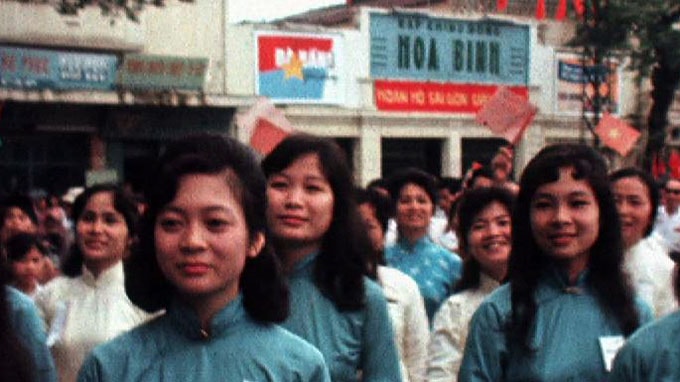5 minutes of Vietnam Memories every day on VTV
On the anniversary of the August Revolution (August 19, 2013), VTV1 will broadcast the first documentary episode in the series Vietnam Memories, which has long been part of the huge wartime archive of Japanese television station NDN.
Photo provided by VTV
After three years of negotiating to obtain the only color film copy, two years of groping and struggling with a warehouse of visual memories that filled a large room, reporters from VTV1 News Department and their colleagues released the first episodes of Vietnam Memories.
History is objective but history also has a heart.
North Vietnam in the 1960s. A group of filmmakers from the Japanese television station NDN arrived in Hanoi and asked to meet President Ho Chi Minh. Their wish was to set up a representative office in Vietnam. President Ho Chi Minh agreed. It was the only international television station with a representative office in Hanoi during those years.
And with the approval of President Ho Chi Minh, NDN became the only international television station to broadcast all information and images about North Vietnam during the period from 1964 to 1981, especially during the most intense period of the war: when the bombing began (February 1965) until peace was restored throughout Vietnam after the Paris Agreement.
For 17 years, every day, Japanese television filmmakers, with 16mm plastic cameras, carried their cameras all over Hanoi and the surrounding areas to capture what they saw: Fidel with his tall figure being hugged and kissed by Vietnamese children, Uncle Ho sitting on the floor in front of the Presidential Palace chatting comfortably with a group of foreign friends, General Secretary Le Duan visiting a Hanoi family on the eve of Tet, or a swimming competition of the mass sports movement at the 10-10 swimming pool (Ba Dinh), a spectacular scene of jumping from The Huc bridge into the clear blue Hoan Kiem lake to cool off on a summer afternoon by the boys of the old quarter, a scene of irrigation work to fight drought by the Northern farmers, a scene of devastation when the Hai Phong cement factory was dropped by American bombs, the bright smile of a flower seller on Hang Luoc street on Tet holiday...
Moderate, meticulous and objective like the Japanese nature, 1,510 television reports with 6,000 minutes of film spanning a historical period calculated as a person's youth. The film is very well preserved, no scratches, no smudges, no mold, with the original Japanese narration broadcast on NDN or Western stations retrieved at that time.
"A treasure trove of extremely valuable documents not only for us, those who work in television, but also for all of us, Vietnamese people who experienced those years or were born after the war. It is valuable because it is truthful and objective. But it is also valuable because it is full of humanity, full of sympathy and sharing with us during the war. That is why VTV wants to introduce it to all of its audience" - journalist Le Quang Minh, head of VTV1's current affairs department, said very enthusiastically.
"I hope many people recognize themselves in Vietnam Memories"
One surprise for the VTV1 film crew when taking over the film archive was that they did not expect it to be so large, the workload to be so great, and especially the things they... "didn't know what" in the film were so many. For example: a factory area caught fire after a series of bombs, the report had a very short commentary, and the subject was not identified. And so, an advisory board was established: veteran cameraman Nguyen Huu Tuan, director People's Artist Thanh Van, journalist - "subsidy scholar" Nguyen Ngoc Tien, writer "old town" Nguyen Viet Ha. The mission of the advisory board was simple but not simple: for each "unknown" frame, it had to be clearly stated: Who? Where? How? And if it was still not certain, it was necessary to find someone else to ask for clarification.
Cinematographer Nguyen Huu Tuan said: "It was a strange reunion. In 1968, I was 20 years old, studying in a film class, we went to practice by carrying cameras to the streets of Hanoi. And we met Japanese cinematographers - the only foreigners in Hanoi at that time. We couldn't film that much because we didn't have much film to film, we couldn't keep it because of the war, because of the climate. Too many things have been lost over time, and looking at these images makes me realize that there must be a way to preserve memories accurately. There are many things that my generation of course knows, but young people of course can't know, for example, the image of the Hai Phong cement factory in the film. Our job is to clearly identify those things that seem obvious."
Journalists Xuan Tung and Gia Hien are quite worried about the progress of their team's "film release": "We have completed 16 episodes and are editing 15 more, enough to last two months. The amount of material that needs to be processed is too much, the historical witnesses appearing in the film need to be identified and need to be met again too much. Japanese filmmakers filmed material to be broadcast daily on Japanese television at that time, so they had very little necessary explanations for "insiders" like us."
That's why the film crew hopes most when the film airs: after about the first two weeks, people will start to pay attention to the program and will recognize themselves, or their parents, uncles, relatives, siblings, or their house, neighborhood, or souvenirs from that day, and there will be feedback, the story of Vietnam Memories will be extended because the film series itself has not ended.
According to Tuoi Tre - TH






